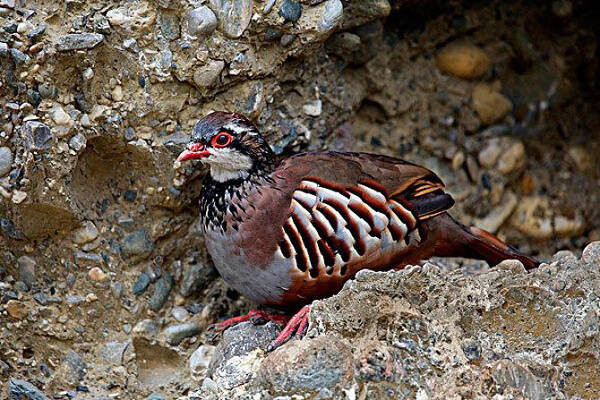Alectoris rufa
IUCN
LCBasic Information
Scientific classification
- name:Alectoris rufa
- Scientific Name:Alectoris rufa,Red-legged Partridge
- Outline:Landfowl
- Family:Gallinariformes P.family Grouse
Vital signs
- length:About 38 cm
- Weight:391-514g
- lifetime:No textual research information is available
Feature
The irises are brown, the mouth is red, and the claws are red, with heavy markings
Distribution and Habitat
Origin: Andorra, France, Germany, Italy, Portugal, Spain.
Introduced: Algeria, Greece, Ireland, New Zealand, United Kingdom.
Travellers: Belgium, Luxembourg, Netherlands, Switzerland.
It inhabits rocky slopes and rocky grassland areas in mountainous and dry hilly areas, as well as high mountains with more shrubs and trees, and also in forest rim shrubland and high mountain areas with more trees. The vertical altitude of the habitat is about 1300 meters, and it can be as high as 2000 meters. In winter, it goes down to low altitude areas such as low mountains, foothills, plains, valleys, canyons, and even rocky desert fields. Generally do not enter the forest and wet areas. It is often found in orchards, plantations, cropland, grassy hillsides, but also in dry cropland, wasteland, and sand dunes.
Appearance
The red-legged cockerel is medium in size, 38 cm long, 47-50 cm wingspan, and 391-514 g in weight. It's a very heavily spotted quail. The crown and nape of the head are brown, showing a short crest when the bird is frightened or excited. The chin and throat are white, and the black stripes of the lower face pass over the eyes and the lower throat, forming a black collar. Contrast with bright red mouth and fleshy red eye circles. The black feathers continue down, forming black triangular patches on the light gray chest. It ends in a thin strip behind the black stripe on the neck. The lower neck is tan with small black markings. The upper body is powder-gray, the chest is yellow-orange, and the flanks have black and maroon stripes and white stripes, each showing a fine black and white edge on a light blue-gray background. There are slight differences among the subspecies, with desert being the weakest. Iris tan, surrounded by red circles; Red mouth; Legs and PAWS red.
Details
Red-legged Partridge (Alectoris rufa) has three subspecies.

Early in the morning and at dusk, the rooster often stands on a bare rock or high ground and calls loudly, issuing a series of higher and higher repeats of "Go CHAK-CHAK-CHAK; Go CHAK Go CHAK-CHAK......” The sound, followed by a nasal cluck of a few vocal chords, begins slowly, then gradually accelerates and repeats many times.

Listed on the International Union for Conservation of Nature (IUCN) 2016 Red List of Threatened Species ver 3.1 - Not Threatened (LC).
Protect wild animals and eliminate wild meat.
Maintaining ecological balance is everyone's responsibility!








